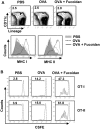Fucoidan can function as an adjuvant in vivo to enhance dendritic cell maturation and function and promote antigen-specific T cell immune responses
- PMID: 24911024
- PMCID: PMC4049775
- DOI: 10.1371/journal.pone.0099396
Fucoidan can function as an adjuvant in vivo to enhance dendritic cell maturation and function and promote antigen-specific T cell immune responses
Abstract
Fucoidan, a sulfated polysaccharide purified from brown algae, has a variety of immune-modulation effects, including promoting antigen uptake and enhancing anti-viral and anti-tumor effects. However, the effect of fucoidan in vivo, especially its adjuvant effect on in vivo anti-tumor immune responses, was not fully investigated. In this study, we investigated the effect of fucoidan on the function of spleen dendritic cells (DCs) and its adjuvant effect in vivo. Systemic administration of fucoidan induced up-regulation of CD40, CD80 and CD86 expression and production of IL-6, IL-12 and TNF-α in spleen cDCs. Fucoidan also promoted the generation of IFN-γ-producing Th1 and Tc1 cells in an IL-12-dependent manner. When used as an adjuvant in vivo with ovalbumin (OVA) antigen, fucoidan promoted OVA-specific antibody production and primed IFN-γ production in OVA-specific T cells. Moreover, fucoidan enhanced OVA-induced up-regulation of MHC class I and II on spleen cDCs and strongly prompted the proliferation of OVA-specific CD4 and CD8 T cells. Finally, OVA immunization with fucoidan as adjuvant protected mice from the challenge with B16-OVA tumor cells. Taken together, these results suggest that fucoidan can function as an adjuvant to induce Th1 immune response and CTL activation, which may be useful in tumor vaccine development.
Conflict of interest statement
Figures






Similar articles
-
Ascophyllan functions as an adjuvant to promote anti-cancer effect by dendritic cell activation.Oncotarget. 2016 Apr 12;7(15):19284-98. doi: 10.18632/oncotarget.8200. Oncotarget. 2016. PMID: 27008707 Free PMC article.
-
Protein-bound polysaccharide activates dendritic cells and enhances OVA-specific T cell response as vaccine adjuvant.Immunobiology. 2013 Dec;218(12):1468-76. doi: 10.1016/j.imbio.2013.05.001. Epub 2013 May 13. Immunobiology. 2013. PMID: 23735481 Free PMC article.
-
Polysaccharides from Ganoderma formosanum function as a Th1 adjuvant and stimulate cytotoxic T cell response in vivo.Vaccine. 2014 Jan 9;32(3):401-8. doi: 10.1016/j.vaccine.2013.11.027. Epub 2013 Nov 17. Vaccine. 2014. PMID: 24252697
-
Human dendritic cell subsets and function in health and disease.Cell Mol Life Sci. 2015 Nov;72(22):4309-25. doi: 10.1007/s00018-015-2005-0. Epub 2015 Aug 5. Cell Mol Life Sci. 2015. PMID: 26243730 Free PMC article. Review.
-
The Broad Immunomodulatory Effects of IL-7 and Its Application In Vaccines.Front Immunol. 2021 Dec 10;12:680442. doi: 10.3389/fimmu.2021.680442. eCollection 2021. Front Immunol. 2021. PMID: 34956167 Free PMC article. Review.
Cited by
-
Maturation of dendritic cells by pullulan promotes anti-cancer effect.Oncotarget. 2016 Jul 12;7(28):44644-44659. doi: 10.18632/oncotarget.10183. Oncotarget. 2016. PMID: 27341129 Free PMC article.
-
Cancer immunotherapy using a polysaccharide from Codium fragile in a murine model.Oncoimmunology. 2020 Jun 1;9(1):1772663. doi: 10.1080/2162402X.2020.1772663. Oncoimmunology. 2020. PMID: 32923129 Free PMC article.
-
Marine Polysaccharides in Pharmaceutical Applications: Fucoidan and Chitosan as Key Players in the Drug Delivery Match Field.Mar Drugs. 2019 Nov 21;17(12):654. doi: 10.3390/md17120654. Mar Drugs. 2019. PMID: 31766498 Free PMC article. Review.
-
Fucoidans and Bowel Health.Mar Drugs. 2021 Jul 30;19(8):436. doi: 10.3390/md19080436. Mar Drugs. 2021. PMID: 34436275 Free PMC article. Review.
-
Anti-Proliferative and Pro-Apoptotic vLMW Fucoidan Formulas Decrease PD-L1 Surface Expression in EBV Latency III and DLBCL Tumoral B-Cells by Decreasing Actin Network.Mar Drugs. 2023 Feb 18;21(2):132. doi: 10.3390/md21020132. Mar Drugs. 2023. PMID: 36827173 Free PMC article.
References
-
- Banchereau J, Steinman RM (1998) Dendritic cells and the control of immunity. Nature 392: 245–252. - PubMed
-
- Banchereau J, Palucka AK (2005) Dendritic cells as therapeutic vaccines against cancer. Nature reviews Immunology 5: 296–306. - PubMed
-
- Pooley JL, Heath WR, Shortman K (2001) Cutting edge: intravenous soluble antigen is presented to CD4 T cells by CD8- dendritic cells, but cross-presented to CD8 T cells by CD8+ dendritic cells. Journal of immunology 166: 5327–5330. - PubMed
-
- Shortman K, Heath WR (2010) The CD8+ dendritic cell subset. Immunological reviews 234: 18–31. - PubMed
Publication types
MeSH terms
Substances
Grants and funding
LinkOut - more resources
Full Text Sources
Other Literature Sources
Research Materials

